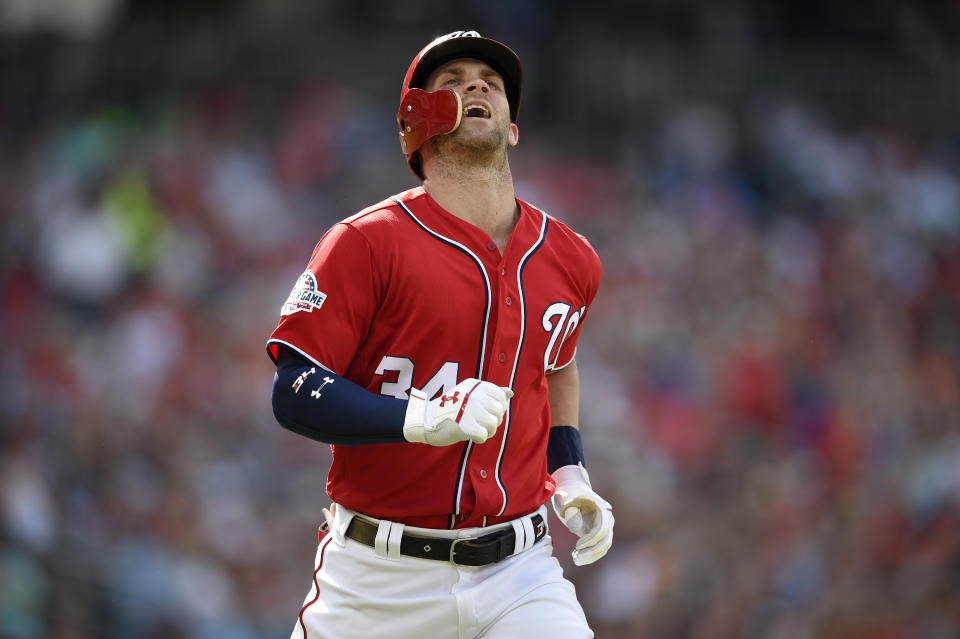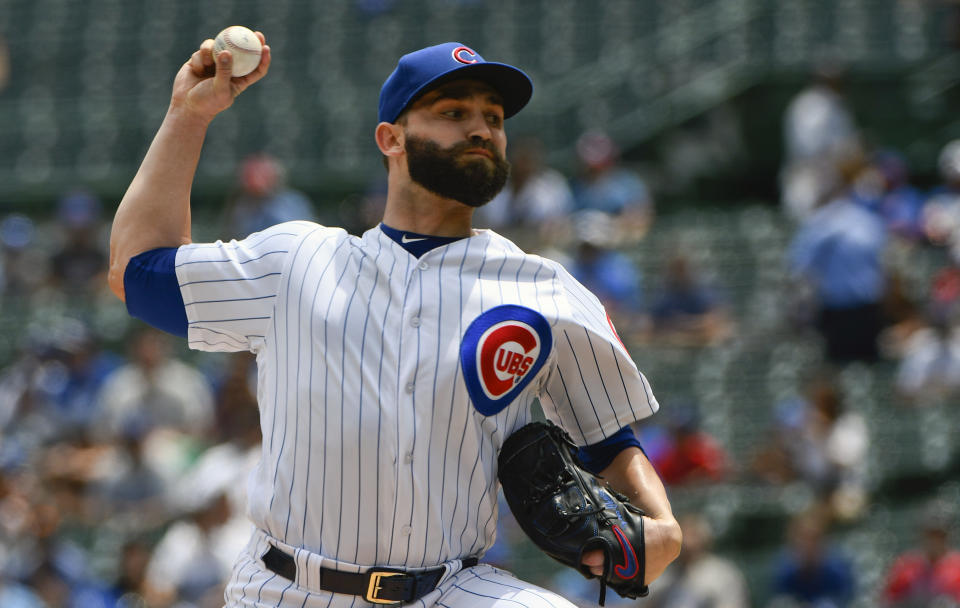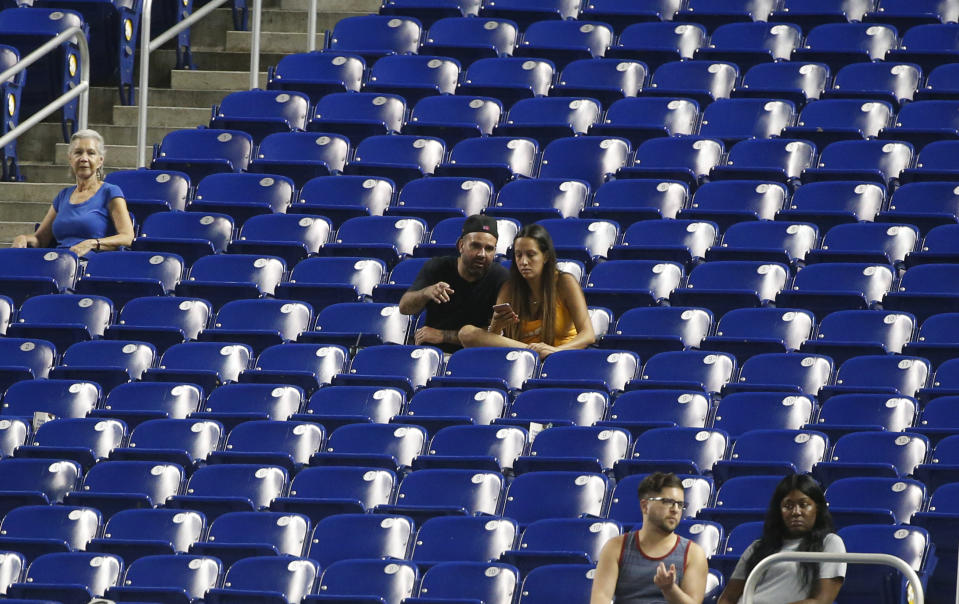10 Degrees: How the Orioles and Royals could be among the worst teams in baseball history
It takes a truly special team to do what the Baltimore Orioles and Kansas City Royals are doing in 2018. The Houston Astros tried for three years and couldn’t muster it. The 1996 Detroit Tigers featured arguably the worst pitching staff in history and whiffed. The Marlins tore themselves down to the studs multiple times and never came close.
For a Major League Baseball club to win fewer than 50 games takes unique ineptitude, and yet here the Orioles and Royals are, primed to do in the same year what only two teams have managed in the 58 years of the 162-game schedule.
The 2018 season passed its halfway point last week, and the Orioles are on pace to win 47 games and the Royals 49. Along with the Chicago White Sox, whose 57-105 pace would register as the second worst in their 118-year history, the Orioles and Royals epitomize an American League in which the excellence of the New York Yankees, Boston Red Sox and Houston Astros balances out the dreadfulness of a squalid bottom.

What’s most amazing is the Orioles and Royals haven’t even emptied their major league coffers to trade-hungry suitors yet. For Baltimore, particularly, the ability to get significantly worse is real in both the talent it stands to shed as the trade deadline approaches this month and the fact that its schedule includes 29 games against the aforementioned three juggernauts and the Seattle Mariners, all of whom are at 103-win-or-better paces.
The race between the …
1. Baltimore Orioles and Kansas City Royals to territory previously inhabited by only the 2003 Detroit Tigers (43-119) and 1962 New York Mets (40-120) is the Orioles’ to lose, even if the Royals, statistically, have been the worse team this season.
Kansas City’s ability to combine the paltriest offense in the major leagues (288 runs scored) with the most generous pitching staff (446 runs allowed) is awfully impressive and impressively awful. The Royals’ 25-58 record is actually a game better than their -158 run differential would expect them to be. The Orioles’ -123 run differential is similarly awful but not quite as impressive. They’ve got the second-worst hitters and fifth-friendliest pitchers.
Going into Sunday, the Royals’ OPS was .664 and the Orioles’ .665. Kansas City’s ERA was 5.20 and Baltimore’s 4.88. Futility would seem to lean in the Royals’ direction if not for the certainty that the Orioles deal their best player, pending free agent Manny Machado, and their shopping of relievers Zach Britton and Brad Brach. Additionally, the Orioles could try to move Adam Jones, though his 10-and-5 rights – 10 major league seasons, five in a row with the same time – give him the ability to veto any deal.
Whatever happens, the Orioles and Royals are suffering through misery even the greatest pessimist wouldn’t have foreseen. They are far from the only ones. Whether it is players, teams or other more inanimate aspects of the game, the embouchure of the sad trombone is not limited to those two. Surely nobody figured on July 1 the …
2. Washington Nationals would be 42-40 and in third place in the National League East. Particularly if you’d said that 19-year-old Juan Soto was going to be OPSing almost 1.000 over the first month-plus of his career and that the Nats were going to make a strike-quick move to trade for reliever Kelvin Herrera and that Max Scherzer would have 165 strikeouts through 17 starts and that Jeremy Hellickson would provide 10 starts of 2.63 ERA ball.

A combination of injuries and ineffectiveness have mitigated that. Daniel Murphy missed more than two months and made his first start at second base Sunday. Adam Eaton has played in a third of the Nationals’ games. Ryan Zimmerman, Matt Wieters, Howie Kendrick – hurt, hurt, hurt. Stephen Strasburg has been on the DL for close to a month and just threw his first bullpen session. And then there’s Bryce Harper, in his walk year, aiming for a $400 million-plus deal, slashing .216/.366/.475, which is good but not $400 million good.
The Nationals find themselves just six games back of the East-leading Atlanta Braves and three behind the Philadelphia Phillies. Those deficits could vanish in a week. First-year manager Dave Martinez could make the Dusty Baker dreamers forget. The Nationals could actually win a playoff series. They still have an awfully good argument to make as the most talented team in the NL, and yet it’s at the point where talent needs to translate into something more. That’s not exactly the story of the …
3. New York Mets, but it’s pretty close. They were talented enough, remember, to start 11-1, and it wasn’t against total pushovers: the St. Louis Cardinals, the Phillies, the Nationals, the Miami Marlins, the Milwaukee Brewers – that’s four winning teams of five.
The implosion since resembles Baltimore and Kansas City. In the 69 games since their phenomenal start, the Mets are 22-47. Not nice. Over the winter, the Mets guaranteed $88 million to Jay Bruce, Todd Frazier, Jason Vargas, Anthony Swarzak and Jose Reyes. Combined, they’ve been worth -1.1 wins above replacement, according to FanGraphs. In other words, the Mets theoretically could have plucked five players from their Triple-A roster, paid them each the league minimum and been better than they’ve been with the guys they guaranteed $88 million.
These are decisions the Mets must own at every level, particularly all the way at the top, where we are reminded every July 1 of the foolhardiness Fred and Jeff Wilpon represent. It is on this great American holiday, Bobby Bonilla Day, that the Mets pay $1,193,248.20 to a man who last played for them in 1999. They were willing to defer the money in Bonilla’s contract, remember, because the returns they were getting from jailed Ponzi schemer Bernie Madoff exceeded the money they would owe Bonilla.
So is this simply karmic justice, the world getting even with the Wilpon family by attacking its most precious asset? No. Mismanagement doesn’t work that fashion. It’s not mystical. It’s systemic, and it manifests itself in so many ways, chief among them, in this case, an ownership group that cannot be trusted by those in baseball operations because they’re forever in the dark about the franchise’s short- or long-term plans.
At least the idea of the …
4. Mega-pen was fully formed when the Colorado Rockies set out this offseason to build the NL’s version of what the Yankees had ridden to the postseason last year and the Royals to a championship in 2015.
To call it a calamity would be kind. Among Wade Davis, Bryan Shaw and Jake McGee, the Rockies guaranteed $106 million – or $4 million fewer than Boston paid for J.D. Martinez. The three have thrown 98 1/3 innings, allowed 157 baserunners, surrendered 17 home runs, uncorked 16 wild pitches and combined for a 5.95 ERA. Add in Mike Dunn, the canary to whom the Rockies gave $19 million a year earlier, never saw him emerge from the coal mine and thought, “Eh, whatever,” and that ERA jumps to 6.37.
Look, it’s hard to pitch in Colorado. A quarter-century into the franchise’s existence, that’s obvious. And yet it is baseball canon, even among those who might not be sabermetrically inclined, that the most volatile asset in the game is relief pitching, and that spending on relievers is incredibly dangerous. Granted, in a game where …
5. The walk rate has crept back to levels not seen in a decade, spending on starters is not exactly safe, either. And while the triceps injury that turned into an elbow impingement has the Cubs wondering about their investment in Yu Darvish, their lower-cost signing is giving them pause of a different variety.
Tyler Chatwood has started 15 games for the Cubs. In those games, he has thrown 73 1/3 innings. And in those 73 1/3 innings, he has walked 66 batters. Never known for his control, Chatwood’s wildness this year is approaching levels unseen in decades – and it says something about the quality of his stuff, and of the Cubs’ fielders, that the walks haven’t translated into an ERA far worse than his 4.54.

Let’s say Chatwood makes 16 more starts this season and keeps his same innings- and walks-per-game rates. That would mean 70 more walks. The last pitcher to walk at least 136 batters in a season: Randy Johnson in 1992 with 144. Only one pitcher in history has thrown at least 150 innings with a higher walk rate than Chatwood, who has issued free passes 19.4 percent of the batters he has faced: the Yankees’ Tommy Byrne in 1949 at 20.3 percent, a year in which he also led the league in strikeouts per nine.
Chatwood isn’t there. It’s a bonus to get him through the sixth inning, which he’s done just three times this season. The notion of him throwing a …
6. Complete game is laughable, though that goes for all of the major leagues. One year after big league pitchers registered 59 complete games total – fewer than Jim McCormick, Pud Galvin, Old Hoss Radbourn and other contemporaries did by themselves in single seasons multiple times in the 1880s – the death of the CG is even more stark.
The eight-inning complete game from Kansas City’s Brad Keller was the 24th from a big league pitcher this season. In June, there were four total, one apiece from Mike Foltynewicz, Andrew Heaney, Jose Berrios and Marco Gonzales. The AL leaders are Carlos Carrasco, James Paxton and Jose Berrios with two each. Not a single NL pitcher has more than one. There are nine pitchers with …
7. $150 million-plus contracts and together they’ve got three: one from Scherzer, one from Justin Verlander, one from David Price and none from Strasburg, Clayton Kershaw, Zack Greinke, Felix Hernandez, Jon Lester or Masahiro Tanaka.
The $150 million deal is the new $100 million deal, in that today it’s truest the sign of elite money. Only 22 players have them. Teams didn’t give out one last year. And for all the great performances by Scherzer and Verlander and Lester, it has not been a good year for the 150-plus club.

Giancarlo Stanton has been good but not great. Miguel Cabrera is out for the year. Robinson Cano got popped for PEDs. Albert Pujols looks like a shadow of his former self. Price got wrecked Sunday. Kershaw has been hurt most of the year. Jason Heyward, while better, is still not a $188 million player. Felix Hernandez is a mess. Chris Davis has been the worst player in baseball. Troy Tulowitzki hasn’t taken a single at-bat. Jacoby Ellsbury is eh.
That’s half the group, and when Stanton and Matt Kemp are the two brightest spots outside of the just-signed Jose Altuve on the hitting side, it reminds that judging hitting talent, particularly aging hitting talent, is difficult, too. Even younger players seem to have forsaken …
8. Batting average for other priorities, and June marked the second month this season in which players had more hits than strikeouts. In April, the league hit .244, in May .249 and in June .245. This dip in batting average – down to .246, nine points lower than last season – is real, it’s not going anywhere and it’s putting 2018 in some awfully ignominious company.
The last time MLB finished a season with a batting average this low was 1972, when the league hit .244. As it stands, this would be the fifth-lowest average in the last century, behind 1965, ’72, ’67 and ’68, when the league hit .237 and shaved five inches off the mound.
Outlawing the shift, an idea that has gained traction around the game, would, at very least, allow left-handed hitters the opportunity for more singles – because that’s what baseball needs: more singles! Surely if the singles started dropping, the game wouldn’t have bled more than 2 million fans in the biggest …
9. Attendance crisis the sport has seen since the 1994 strike. MLB is on pace to drop well below the 70 million-fan mark for the first time since 2003, and for those whose admonition that writing about the attendance two weeks into the season was too early, perhaps a mea culpa is in order, because it’s as obvious now as it was then that this has far more to do with outside factors than it did the weather.

This is a crisis because the greatest product MLB owns isn’t its sterling streaming technology or its local television contracts. It’s the live game, the in-person experience, the peanuts and Cracker Jack, the smell of fresh-cut grass and taste of hot dog washed down by a beer. It is the cliché baseball has sold, reliably, for decades.
And now, in increasing numbers, people are not buying it. Right now, two teams are on pace to draw a half-million more fans than they did last season: the Brewers and Astros. Six teams are primed to lose that many: the Toronto Blue Jays, Pittsburgh Pirates, Tigers, Marlins ..
10. Baltimore Orioles and Kansas City Royals – all of whom have in common a losing record and a clear desire not to spend significant money in the offseason. This is not a coincidence. There are other factors certainly. The Marlins are actually reporting their real attendance numbers – and they’re under 10,000 per game. The Blue Jays are the biggest mess of all, down more than 11,000 per game amid cratering season-ticket sales. Pittsburgh didn’t sign a single major league free agent this winter. Detroit spent less than $12 million total on Mike Fiers, Francisco Liriano and Leonys Martin.
When there are mega-teams like the Astros and Yankees and Red Sox, competing is difficult. And yet look at the NL right now. There is no great team. The Braves, who were supposed to be a year away from competing, own the best record at 48-34 – a 95-win pace. And while the Marlins, Mets, Cincinnati Reds and San Diego Padres may flirt with it, no team is on pace at the moment to lose even 98 games. Which is to say: If you are an NL team and you’re not trying to win, shame.
The calculus in the AL is a touch different, and the Orioles are looking like the odds-on favorite to select No. 1 overall in the draft for the first time since they took Ben McDonald in 1989. The Royals are keen competitors, yes, but they do not have to face the Yankees 13 times, and they do not have to face the Red Sox nine times, and they do not have an all-time end-of-season gauntlet.
The Orioles’ final 10 games of the season go: three at the Yankees, three at the Red Sox, four at home against Houston. If they head into that stretch with 46, 47, even 48 wins, history will be watching. It takes something not to win 50 games, and the 2018 Baltimore Orioles may just be that kind of special.
More from Yahoo Sports:
• LeBron agrees to join the Lakers on 4-yr, $154M deal
• Celtics draft pick misses flight, continues to make terrible first impression
• NBA Twitter reacted accordingly to LeBron joining the Lakers
• Russia fined after fans display Neo-Nazi banner at World Cup


